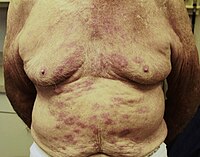
Photo from wikipedia
More than 107 pathogenic variations were identified in Keratin 14 gene (KRT14) in patients affected by epidermolysis bullosa simplex (EBS), a rare skin disease with still no curative treatment. Disease… Click to show full abstract
More than 107 pathogenic variations were identified in Keratin 14 gene (KRT14) in patients affected by epidermolysis bullosa simplex (EBS), a rare skin disease with still no curative treatment. Disease models as human induced pluripotent stem cells (hiPSCs) are promising tool for further advance the knowledge about this disorder and accelerate therapies development. Here, two hiPSC lines were reprogrammed from skin fibroblasts of two EBS patients carrying mutations within KRT14 by using CytoTune®Sendai virus. These iPSCs display pluripotent cell morphology, pluripotent markers expression, and the capability to differentiate into the three germ layers.
Journal Title: Stem cell research
Year Published: 2022
Link to full text (if available)
Share on Social Media: Sign Up to like & get
recommendations!